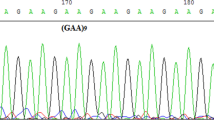Abstract.
Ataxia with vitamin E deficiency (AVED) is a rare autosomal recessive neurodegenerative disorder due to mutations in the alpha-tocopherol transfer protein (TTPA) gene on chromosome 8q13. AVED patients have progressive spinocerebellar symptoms and markedly reduced plasma levels of vitamin E. We studied neurological phenotype at diagnosis, and long-term effect of vitamin E supplementation in 16 patients from 12 Italian families. The most common mutations were the 744delA and 513insTT. Two novel TTPA mutations were identified: a severe truncating mutation (219insAT) in a homozygous patient, and a Gly246Arg missense mutation (G246R) in a compound heterozygous patient. The missense mutation was associated with a mild and slowly progressive form of the disease. Vitamin E supplementation therapy allowed a stabilization of the neurological conditions in most of the patients. However, development of spasticity and retinitis pigmentosa was noted in a few patients during therapy. Prompt genetic characterization of AVED patients may allow an effective early treatment and an adequate genetic counseling.
Similar content being viewed by others
Author information
Authors and Affiliations
Corresponding author
Rights and permissions
About this article
Cite this article
Mariotti, C., Gellera, C., Rimoldi, M. et al. Ataxia with isolated vitamin E deficiency: neurological phenotype, clinical follow-up and novel mutations in TTPAgene in Italian families. Neurol Sci 25, 130–137 (2004). https://doi.org/10.1007/s10072-004-0246-z
Received:
Accepted:
Issue Date:
DOI: https://doi.org/10.1007/s10072-004-0246-z




